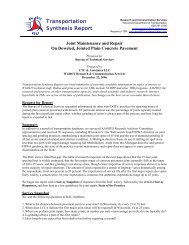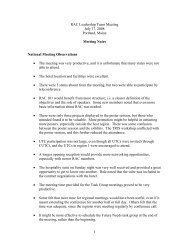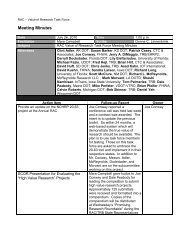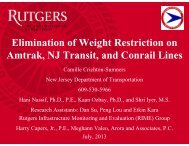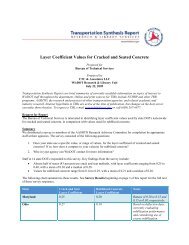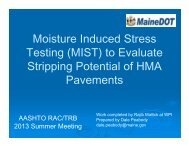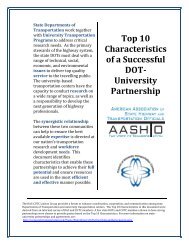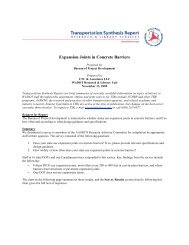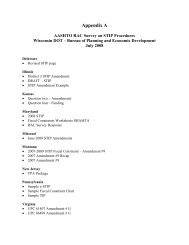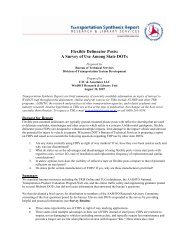PART IV: Summary of Comments - SCOR/RAC
PART IV: Summary of Comments - SCOR/RAC
PART IV: Summary of Comments - SCOR/RAC
You also want an ePaper? Increase the reach of your titles
YUMPU automatically turns print PDFs into web optimized ePapers that Google loves.
<strong>PART</strong> <strong>IV</strong>: <strong>Summary</strong> <strong>of</strong> <strong>Comments</strong>17-May-10Reviewer <strong>Comments</strong> Distribution <strong>of</strong> Ratings■ Not a well written proposal. Side paths are important and design guidance is needed but the proposal seems to addressmany issues relevant to motorized transportation. Question whether sufficient data is available to analyze bicyclecrashes, and human factors.■ Conduct synthesis first as reviewer suggests■ Separated bikeway design criteria could pose substantial challenges to the designer with regard to ROW width, sightdistance, pedestrian movements & operational issues; aesthetic implications, while secondary, would also be <strong>of</strong> concern.(Design)■ Consider a limited scope synthesis project?■ As designers start to think about “TOD” or Transit Oriented Design and going green. More research is needed on thedesign options for separated cyclist lanes. Mixed use paths address the various kinds <strong>of</strong> commuter from walker, jogger,and cyclist. However as congestion increases the need too separate pedestrians from faster moving cyclist are needed.There is a need to investigate successful European separated bikeway use and safety, then incorporating this into designguidance for North America.■ With the ever increasing use <strong>of</strong> shared use paths adjacent to roadways, this research could be beneficial.Other■ [Rating: 4]Item #78:C-09Study <strong>of</strong> Vehicle Paths on Horizontal Transition Curves(17)(46)NR 0 1 2 3 4 5<strong>SCOR</strong> 1 3 4 5 3 1<strong>RAC</strong> 1 2 8 10 15 9 4Standing Committee on Research■ This is interesting theoretical work that fills some gaps where there is little research behind Green Book standards. Thisis related to 2011-G-08, so if both are ranked highly, they will need to be coordinated. Interesting but not a high priority■ The AASHTO Technical Committee on Geometric Design, strongly supports conducting this research and believes thatthe urgency for and potential pay<strong>of</strong>f from this research is high because it supports the AASHTO Strategic HighwaySafety Plan for reducing truck-related crashes.■ We are very comfortable with our current practice <strong>of</strong> using spirals. This seems like a research project to come up with analternate for spirals when spirals normally work for us.■ Combine with G-08.■ [Rating: 3] This proposal is phase one <strong>of</strong> a two-phase effort to clarify the importance <strong>of</strong> transition curves and determineneeds related to the design policy. This research can also help to justify and guide future work to reduce truck-relatedcrashes at transition curves and provide needed design guidance in a future edition <strong>of</strong> AASHTO design policy.Research Advisory Committee■ High Priority Needed for Green Book and Practioners nationwide.■ Well presented discussion and objectives. This is <strong>of</strong> national interest.■ Related to G-8.■ The Policy on Geometric Design <strong>of</strong> Highways and Streets does not provide sufficient guidance for designingimprovements to existing potentially dangerous transitional horizontal curves. The researchers suggest studying thesignificant amount <strong>of</strong> existing research in the study area to produce valuable guidelines along with crash data to beeventually included in the Green Book, leading to a reduction in truck rollover crashes out <strong>of</strong> a transition.<strong>IV</strong>-55



